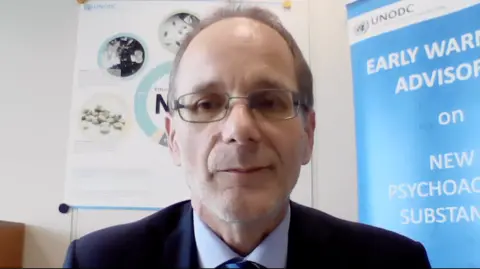Hazardous new drugs found in fake medications across the UK
Super-strength drugs linked to hundreds of deaths have been found in samples of fake medicines bought across the UK, the BBC can reveal.
We found more than 100 examples of people trying to buy prescription medicines such as diazepam - commonly used to treat anxiety, muscle spasms and seizures - and instead receiving products containing nitazenes.
The synthetic opioid drugs have been connected to 278 deaths across the country in a year, according to the National Crime Agency (NCA). Nitazenes can be stronger than both heroin and fentanyl, a prolific killer in the US.
Martin Raithelhuber, an illicit synthetic drug expert from the United Nations Office on Drugs and Crime, said the BBC’s findings were a “very worrying development”.
Warning: This article contains descriptions of drugs use
A government spokesperson said it was “securing our borders from the threat” through “world-leading intelligence, dedicated cross-government taskforce and extensive international networks”.
The contaminated substances were identified in anonymous samples submitted to WEDINOS, the only national drug-checking service in the UK.
It said the fake medicines looked like "the same kind of packet you might get from your chemist on the high street" but were "most likely purchased from illicit online pharmacies".
Anne Jacques had never heard of nitazenes when a police officer knocked at her door in the early hours of 17 July 2023 and said her son had been found dead at his student flat.
Alex Harpum, 23, had been preparing for a career as an opera singer and had been accepted for a two-year masters course.
It was initially suspected the cause of his death was sudden adult death syndrome, but eight months later Alex’s family learned he had taken a substance contaminated with a nitazene.
Phone records suggested he had tried to buy tablets usually sold as Xanax, which are only available with a private prescription in the UK.
Ms Jacques, who lives in north Wales, believes Alex was doing so because he often struggled with sleeping while taking medication for his attention deficit hyperactivity disorder.
The traces of nitazenes were only detected after she queried with police why earlier tests had not looked for them.
Ms Jacques said she remained in “disbelief" at the lack of testing, adding: “If I hadn’t pushed for better answers in the middle of massive grief, then to this day I would have no idea how he actually died.
"Unless we’re testing for them, how is anyone going to be aware and informed [of the dangers]?"
A Scotland Yard spokesperson said there had been “delays beyond the control of the Met” relating to the need for, and timing of, specialist testing in this case.
The North London Coroner Service said it remained in contact with the family regarding their concerns.

The BBC analysed sample results published by WEDINOS, a Public Health Wales service which shares information about the UK’s illegal drugs market. It records what the person submitting each sample said they had intended to buy.
In the year to September 2024, there were 130 instances of someone trying to buy medicines illegally to possess without a prescription, and instead receiving substances contaminated with nitazenes.
Many were purporting to be benzodiazepines, such as diazepam, and insomnia treatments including temazepam and zolpidem.
Nitazenes were also found in substances masquerading as promethazine, an allergy medication.
Professor Rick Lines, from WEDINOS, said: “Perhaps people have found that they weren’t able to continue on a legitimate prescription and decided to go through what they think is an alternative legitimate route, but is in fact not.”
The government plans to make all types of nitazenes Class A drugs. Fifteen synthetic opioids were reclassified in March.
Under the Misuse of Drugs Act, those caught in their supply and production could face up to life in prison while those in possession could face up to seven years.

Mr Raithelhuber said there was a "lesson to learn... from North America", where people became addicted to prescription painkillers before the use of fake medicines containing fentanyl became widespread.
“So here in Europe, we are not yet in that situation, but this could be the early signs of traffickers trying to expand," he said.
“I think it’s a warning call, maybe for all other countries in Europe… that nitazenes are probably here to stay for the time being, and that their potential negative impact on the health of users is huge.”
He said because both benzodiazepines and nitazenes were depressants, “their combined effect increases the risk of overdose significantly”.
Synthetic opioid effects
Signs that someone may have taken one of these drugs:
- Small, narrowed pupils
- Reduced or loss of consciousness
- Dizziness or drowsiness
- Difficulty breathing
- Nausea or vomiting
- Cold or clammy skin
- Blue or grey lips and fingernails
- Low blood pressure or decreased heart rate
Anyone who has consumed synthetic opioids and experiences the symptoms described should seek urgent medical treatment.
Source: Metropolitan Police
The groups of people most at risk were “those who have always been at the highest risk of all drug-related harm,” said Harry Sumnall, a professor in substance use at Liverpool John Moores University.
He said this included people with drug use problems and those “using drugs to help manage their life circumstances”.

The NCA believes nitazenes are being produced in Chinese labs and brought into the UK through the Royal Mail and other parcel operators.
Dark web marketplaces seen by the BBC suggest some of the same online sellers in China are advertising nitazenes in bulk as well as adulterated benzodiazepines.
The Border Force only examines post for drugs if there is a known risk or intelligence. It says dogs trained to detect nitazenes and other synthetic opioids are “due to enter service shortly”.
Its teams seized new synthetic opioids nine times in the past financial year, according to a response under the Freedom of Information Act.
Those seizures ranged in size from 1g to 1.32kg, which experts said could equate to tens of thousands of doses.
The government said it would also test for the presence of the new drugs in wastewater from sewage treatment plants to anticipate the threat of a spike in overdoses.
It has, however, admitted such testing is currently "experimental". The process took around two months at the only laboratory known to have successfully confirmed samples.
Experts previously told the BBC the last government had been too slow to recognise the scale of the problem.
NCA deputy director Charles Yates said it took the threat from nitazenes “seriously” and was taking a “zero-tolerance approach”.
There are an average of 49 drug poisoning deaths weekly involving opiates - such as heroin, oxycodone, fentanyl and including synthetic opioids - across England and Wales, the latest official figures suggest.
Read more similar news:
Comments:
comments powered by Disqus


































